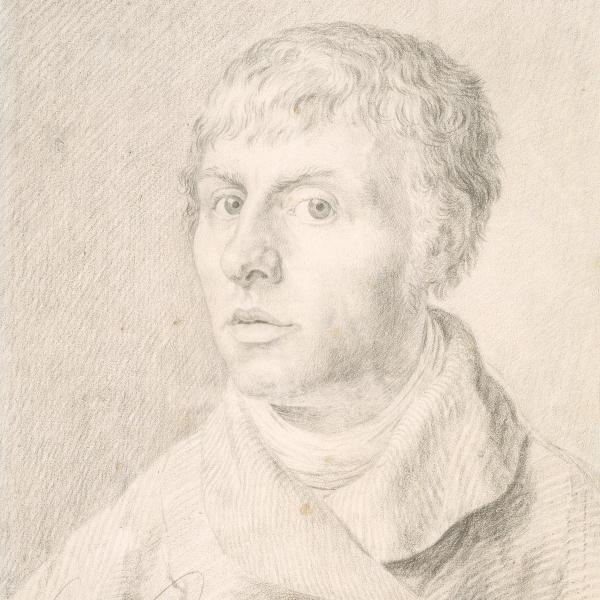Self-Portrait
Artwork Details
- Title: Self-Portrait
- Artist: Caspar David Friedrich (German, Greifswald 1774–1840 Dresden)
- Date: 1800
- Medium: Black chalk on wove paper
- Dimensions: 16 9/16 × 10 7/8 in. (42 × 27.6 cm)
Framed: 27 5/8 in. × 21 5/8 in. × 1 3/16 in. (70.1 × 55 × 3 cm) - Classification: Drawings
- Credit Line: SMK, National Gallery of Denmark, Copenhagen (KKSgb5006)
- Curatorial Department: European Paintings
Audio

371. Forging his Path (Self Portrait, 1800)
Hear about the young Friedrich’s engagement with Romantic ideas.
NARRATOR: Caspar David Friedrich was born in 1774 in a small town on the Baltic Sea. At the age of twenty-four, he settled in the vibrant artistic center of Dresden, his home for the rest of his life.
Here, we see Friedrich two years into his time there, a young artist looking to launch his career.
JOANNA SHEERS SEIDENSTEIN: To me, he portrays himself in a very confident and ambitious manner.
NARRATOR: Joanna Sheers Seidenstein, assistant curator of Drawings and Prints and co-curator of the exhibition.
SHEERS SEIDENSTEIN: And if you look very closely, you can even see the cross in both eyes.
ALISON HOKANSON: He’s drawn them with such precision, they almost seem to drill into you. It’s a really intense glance.
NARRATOR: Alison Hokanson, curator of European Paintings and co-curator of the exhibition.
HOKANSON: And if we think about that in terms of conveying something about him or his identity, there’s a real emphasis there on vision and on sight and on attention, this incredible attention that he has to the world around him.
SHEERS SEIDENSTEIN: This is this moment when there are these new ideas about the self, the individual, circulating. It’s impossible not to read the self portrait with that in mind.
NARRATOR: At this time European artists and thinkers were moving away from Enlightenment ideals, which emphasized science, objectivity, and reason, placing new value on spirituality, subjectivity, and emotion. This intellectual revolution came to be called Romanticism.
HOKANSON: This interest in imagination, this new investment in emotion and in experience. This new sort of curiosity about how we relate to one another and how we relate to the larger world. That all comes out of that moment.
ANDREA WULF: That’s something very important, bringing together humankind in nature, this kind of philosophy of oneness that was so important for them.
NARRATOR: Historian and author of Magnificent Rebels: The First Romantics and the Invention of the Self, Andrea Wulf.
WULF: And this philosophy of oneness then really becomes, I would argue, the heartbeat of Romanticism. And this is really where Caspar David Friedrich comes in because that is what he does.
NARRATOR: In this gallery and the next, you will see early works by Friedrich that reflect the Romantic sense of the individual’s relationship to the natural world. He believed that landscapes had the potential to be transformative:
SHEERS SEIDENSTEIN: This is this moment, really, this breakthrough where he's beginning to focus really entirely on landscape. And these are the works that make a splash.
HOKANSON: It’s almost like a question, is it possible to make a landscape painting so powerful that when you stand in front of it you feel all the emotion, all the meaning, all the moral uplift that people were used to getting when they stood in front of a history painting with figures.
SHEERS SEIDENSTEIN: One of many wonderful things he writes and says about artmaking: he talks about how landscape should create the space for the imagination to play.
###
Music: Brahms, Intermezzo in A major, Op. 118, No. 2, performed by German Kitkin (Piano, Conductor) is licensed under CC-BY-4.0